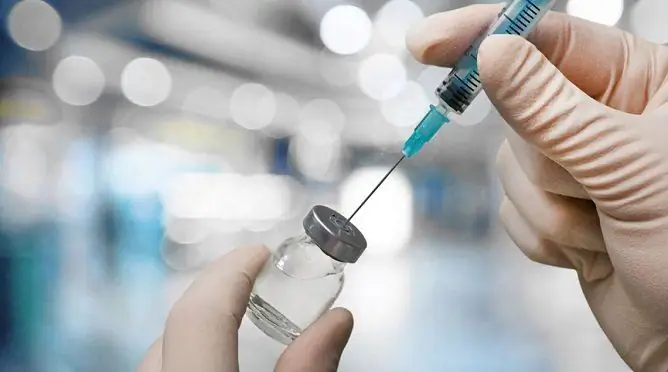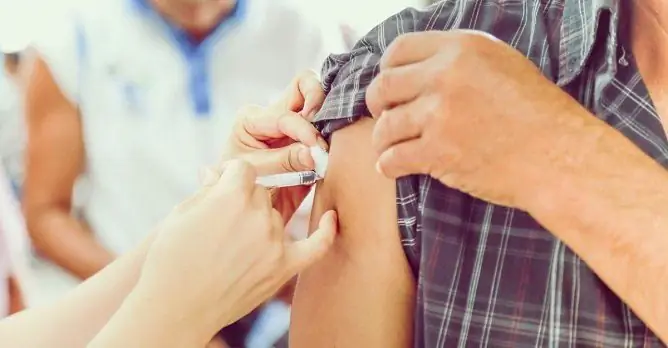- Author Rachel Wainwright [email protected].
- Public 2023-12-15 07:39.
- Last modified 2025-11-02 20:14.
Pneumovax 23
Pneumovax 23: instructions for use and reviews
- 1. Release form and composition
- 2. Pharmacological properties
- 3. Indications for use
- 4. Contraindications
- 5. Method of application and dosage
- 6. Side effects
- 7. Overdose
- 8. Special instructions
- 9. Application during pregnancy and lactation
- 10. Use in childhood
- 11. Drug interactions
- 12. Analogs
- 13. Terms and conditions of storage
- 14. Terms of dispensing from pharmacies
- 15. Reviews
- 16. Price in pharmacies
Latin name: Pneumovax 23
ATX code: J07AL01
Active ingredient: polysaccharides Streptococcus pneumoniae (Pneumococcal polysaccharide vaccine)
Manufacturer: Merck Sharp and Dome Corp. (Merck Sharp & Dohme, Corp.) (USA)
Description and photo update: 2019-27-11

Pneumovax 23 is a vaccine designed to prevent pneumococcal infection.
Release form and composition
The drug is produced in the form of a solution for intramuscular and subcutaneous administration, which is a colorless, transparent liquid (0.5 ml each in colorless glass vials with a capacity of 3 ml, sealed with a cork with aluminum rolling and closed with a plastic lid, in a cardboard box 1 bottle; 0, 5 ml in glass disposable syringes with a capacity of 1.5 ml with a Luer-Lock adapter, a protective cap with a plastic cap and a plunger, in a contour package 1 disposable syringe and 1 stainless steel needle, in a cardboard box 1 or 10 blisters Each pack also contains instructions for the use of Pneumovax 23).
Composition for 1 dose (0.5 ml):
- active substances: polysaccharides of Streptococcus pneumoniae (serotypes 1, 2, 3, 4, 5, 6B, 7F, 8, 9N, 9V, 10A, 11A, 12F, 14, 15B, 17F, 18C, 19A, 19F, 20, 22F, 23F, 33F according to Danish nomenclature) - each serotype 25 μg;
- auxiliary components: phenol, sodium chloride, water for injection.
Pharmacological properties
Pharmacodynamics
The multivalent vaccine for the prevention of pneumococcal infections Pneumovax 23 contains a mixture of highly purified capsular polysaccharides from the 23 most invasive and common serotypes of Streptococcus pneumoniae pneumococcus. This vaccine contains approximately 90% of the serotypes that cause pneumococcal infections in developed and developing countries. In Russia, according to scientific publications, the following pneumococcal serotypes are most common: 3, 6B, 14, 19F, 23F. Serotypes 6B, 19A, 19F and 23F are the most common causative agents of drug-resistant pneumococcal infections.
Pneumococcal infection is one of the leading causes of morbidity and mortality worldwide. It causes dangerous diseases such as meningitis, pneumonia, otitis media and bacteremia.
In the United States and other countries, drug-resistant strains of Streptococcus pneumoniae are more common every year. It is known that in some regions more than 35% of pneumococcal strains are resistant to penicillin. Many of these strains are also resistant to other antimicrobial drugs (cephalosporins, trimethoprim-sulfamethoxazole, erythromycin, etc.), so the importance of vaccine prevention should not be underestimated.
It has been established that the capsular polysaccharides of the vaccine cause the production of antibodies that effectively protect against pneumococcal infection. The immunogenicity of each of the 23 types of capsular antigens has been confirmed by clinical studies.
Usually, protective antibody levels appear by the third week after immunization. Capsular polysaccharides of bacteria stimulate the formation of antibodies through mechanisms that are almost unrelated to the participation of T-lymphocytes. That is why in children under 2 years of age, due to the immaturity of the immune system, the immune response is often unstable or weak.
After the introduction of Pneumovax 23, the levels of specific antibodies gradually decrease, and after 5-10 years, re-vaccination is required. In children and the elderly, the rate of decline in serotype-specific antibodies is more rapid, therefore revaccination may be required to ensure continued protection against pneumococcal infection.
Vaccination efficacy was investigated by the US Centers for Disease Control and Prevention. In persons over 6 years of age, the protective effectiveness of immunization against infections caused by serotypes that are part of Pneumovax 23 was 57%; in patients of special groups (patients with diabetes, people with congestive heart failure, coronary heart disease, chronic heart disease and people with an anatomical absence of the spleen) - 65-84%; in immunocompetent persons over the age of 65 years - 75%.
For some groups of patients with a reduced immune response, the effectiveness of the vaccine could not be confirmed, since it was not possible to recruit a sufficient number of unvaccinated individuals for each disease group. Based on the results of the studies conducted, it can be assumed that vaccination can provide protection for up to 9 years from the moment the first dose is administered.
With an increase in the time after vaccination, its effectiveness decreases, especially in old age (in people over 85 years old).
Pharmacokinetics
There is no data.
Indications for use
Pneumovax 23 is used to prevent pneumococcal infection caused by such pneumococcal serotypes, the antigens of which are present in its composition. The vaccine is administered to children over 2 years old, adolescents and adult patients with an increased risk of pneumococcal infections, as well as people 50 years of age and older.
Application of Pneumovax 23 in immunocompetent patients (with a normal immune response):
- children over 2 years old, adolescents and adults with chronic lung diseases (including emphysema and chronic obstructive pulmonary disease), diabetes mellitus and chronic cardiovascular diseases;
- children over 2 years of age, adolescents and adults with anatomical or functional asplenia (including after removal of the spleen and in the presence of sickle cell anemia);
- children over 2 years old, adolescents and adults with chronic liver diseases (including cirrhosis), alcoholism and liquorrhea;
- children over 2 years old, adolescents and adults living in special social conditions or special environmental conditions (for example, residents of the Far North);
- persons from 50 years and older, for routine vaccination.
Pneumovax 23 is also used in immunocompromised individuals over 2 years old, including for the following diseases and conditions:
- leukemia, multiple myeloma, HIV infection, Hodgkin's disease, advanced cancer, lymphoma, nephrotic syndrome, or chronic renal failure;
- immunosuppressive chemotherapy (including corticosteroids);
- organ transplant or bone marrow transplant.
Revaccination of immunocompetent persons previously vaccinated with Pneumovax 23 is usually not required. However, it should be noted that a single revaccination is recommended for persons over 2 years of age who are at greatest risk of pneumococcal infections, as well as those whose antibody levels may decrease rapidly (provided that at least 5 years have passed since the first dose of the vaccine). The group of people at high risk of pneumococcal infections includes people with anatomical or functional asplenia and immunocompromised patients (see above).
In children aged 2-10 years, who are at high risk for severe pneumococcal infections, revaccination is possible 3 years after the administration of the previous dose of Pneumovax 23.
In the absence of data on prior vaccination status, individuals at increased risk of pneumococcal infections should be immunized with Pneumovax 23 vaccine.
People aged 65 and over who have not been vaccinated within the last 5 years (or were in the age group under 65 at the time of vaccination) should receive another dose of Pneumovax 23. Vaccine safety data when given three times or are no longer sufficient, therefore additional revaccination after the second dose is not recommended.
Persons over 2 years of age with a high risk of serious pneumococcal infections, previously vaccinated with a conjugated pneumococcal vaccine, can be revaccinated with Pneumovax 23 (the interval between the administration of these vaccines should be at least 8 weeks).
Contraindications
Absolute:
- non-infectious and infectious diseases in the acute stage, exacerbation of chronic diseases (this contraindication is temporary; Pneumovax 23 vaccination can be given 2-4 weeks after recovery, as well as during remission or convalescence; in case of mild acute intestinal infections, ARVI and other diseases accompanied by fever, the vaccination can be done immediately after the body temperature drops to normal);
- any respiratory illness with fever or other acute infectious diseases (unless the delay in vaccination, in the opinion of the doctor, is even more dangerous);
- post-vaccination complication or severe reaction to a previous vaccination.
Relative (Pneumovax 23 is used with caution):
- severe dysfunctions of the cardiovascular system;
- severe impairment of pulmonary function;
- simultaneous immunosuppressive therapy.
Pneumovax 23, instructions for use: method and dosage
The Pneumovax 23 vaccine is intended only for subcutaneous or intramuscular administration. It is forbidden to enter it intradermally or intravenously.
Before the introduction, it is necessary to check the contents of the syringe or vial for color change and the presence of mechanical particles (the solution should be transparent, colorless and not contain foreign particles).
The drug is administered in a dose of 0.5 ml intramuscularly or subcutaneously (preferably into the lateral surface of the middle part of the thigh or the deltoid muscle of the shoulder). Precautions must be taken to avoid intravascular administration.
A separate sterile syringe and sterile needle are used for each patient (in order to prevent transmission of infection from one person to another).
The product is ready to use: no reconstitution or dilution is required.
When injecting Pneumovax 23 supplied in vials, the contents of the vial should be drawn into the syringe completely. The syringe must be free of antiseptics, preservatives and synthetic substances.
The vaccine, supplied in pre-filled syringes, is administered once by injecting the entire contents of the syringe.
According to clinical studies conducted in patients aged 65 years and older, the frequency and severity of adverse reactions was comparable to those in people aged 50-64 years. However, in elderly people, especially those who are weak and with concomitant diseases, tolerance to medical interventions may be reduced, therefore, the risk of severe reactions to the drug in some patients over 65 years of age cannot be completely excluded.
Side effects
The most common side effects of Pneumovax 23 are headache, muscle pain, fatigue / asthenia. In most cases, the usual symptomatic therapy led to complete recovery.
Side effects of Pneumovax 23, identified during clinical trials and / or during post-registration use:
- digestive system: frequency unknown - vomiting, nausea;
- nervous system: frequency unknown - headache, acute polyradiculoneuritis, radiculoneuropathy, febrile convulsions, paresthesias;
- lymphatic system and blood: frequency unknown - lymphadenitis, hemolytic anemia (in patients with other hematological diseases), leukocytosis, thrombocytopenia (in patients with idiopathic thrombocytopenic purpura), lymphadenopathy;
- musculoskeletal and connective tissue: frequency unknown - arthritis, muscle pain, arthralgia;
- skin and subcutaneous fat: the frequency is unknown - nettle rash, erythema multiforme, skin rash;
- immune system: frequency unknown - Quincke's edema, anaphylactoid reactions, serum sickness;
- data from laboratory and instrumental studies: frequency is unknown - an increase in the level of C-reactive protein;
- other reactions: very often - disturbances at the injection site (soreness, edema, erythema, sensitivity, hot flush, local induration), fever (up to 38.8 ° C); rarely - phlegmon at the injection site; frequency unknown - fever, chills, malaise, asthenia, decreased mobility and peripheral edema of the limb in which the injection was made.
Overdose
Overdose cases of Pneumovax 23 were not registered.
special instructions
Vaccination with Pneumovax 23 does not protect against diseases caused by pneumococci of other capsule types that are not part of this vaccine.
In people receiving immunosuppressive drugs, serum antibody levels after vaccine administration may be lower than expected. In addition, in such patients, the immune response to pneumococcal antigens may be insufficient.
In case of accidental intradermal administration, severe local adverse reactions may develop.
Like other vaccines, Pneumovax 23 does not guarantee 100% protection for all vaccinated.
Vaccination may also be ineffective for the prevention of infections resulting from the leakage of cerebrospinal fluid into the external environment or as a result of a fracture of the skull base.
If the patient needs antibiotics (for example, penicillin) to prevent pneumococcal infection, such prophylaxis should not be stopped after vaccination with Pneumovax 23.
For a number of diseases, the vaccine should be administered at least 2 weeks before the planned operation to remove the spleen.
When planning immunosuppressive therapy, the interval between the start of therapy and vaccination should be at least 2 weeks. Immunization should be avoided during radiation or chemotherapy. Pneumovax 23 can be administered several months after the completion of radiation or chemotherapy for cancerous tumors.
In patients with Hodgkin's disease, after chemotherapy, the immune response may be reduced for 2 or more years.
In some patients who received intensive chemotherapy or other immunosuppressive therapy (with or without radiation therapy), the immune response was significantly better within 2 years after the end of treatment, especially with an increase in the interval between the end of therapy and the introduction of the vaccine.
Patients with clinically significant HIV infection or asymptomatic disease should be vaccinated as soon as possible after the diagnosis is made.
Influence on the ability to drive vehicles and complex mechanisms
There are no data on the effect of Pneumovax 23 on the ability to drive vehicles and work with potentially dangerous and complex mechanisms.
Application during pregnancy and lactation
It is not recommended to vaccinate pregnant women at risk (despite the lack of information on the adverse effects of the vaccine on the fetus).
Pediatric use
The Pneumovax 23 vaccine should not be given to children under the age of 2 years, since patients of this age group do not develop an effective immune response to vaccine antigens.
Drug interactions
A multivalent vaccine to prevent pneumococcal infections can be given in conjunction with an influenza vaccine (given in the other shoulder). With the simultaneous use of these vaccines, there is no increase in the frequency of side effects or a decrease in the intensity of the immune response of each of the vaccines used.
Pneumovax 23 can be injected on the same day with other immunobiological drugs (except for the tuberculosis vaccine), but using different sterile syringes and in different parts of the body.
Analogs
The analogues of Pnevmovax 23 are Prevenar, Prevenar 13, Pnevmo 23 and Synflorix.
Terms and conditions of storage
Store in a dark place at a temperature of + 2 … + 8 ° C. Keep out of the reach of children.
The shelf life of the vaccine is 2 years.
Terms of dispensing from pharmacies
Dispensed by prescription.
Reviews about Pnevmovax 23
The vaccine was recently registered, so there are very few reviews of Pnevmovax 23. Reviews of similar drugs that appeared on the pharmaceutical market several years earlier (for example, Pnevmo 23) are mostly positive. When used correctly, the vaccine provides immunity against 23 pneumococcal serotypes for up to 5 years. This is especially important for frequently ill children, since ARVI and influenza are often accompanied by complications in the form of pneumococcal infections.
The main disadvantage is the occurrence of such local side effects as pain and numbness at the injection site. Also, patients note the high cost of Pneumovax 23.
Price for Pneumovax 23 in pharmacies
The price of Pneumovax 23 in the form of a solution for injection of 0.5 ml / dose (1 syringe per package) is 2200-2430 rubles.

Maria Kulkes Medical journalist About the author
Education: First Moscow State Medical University named after I. M. Sechenov, specialty "General Medicine".
Information about the drug is generalized, provided for informational purposes only and does not replace the official instructions. Self-medication is hazardous to health!






